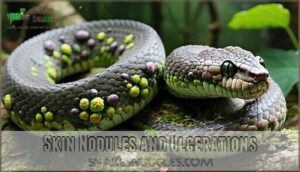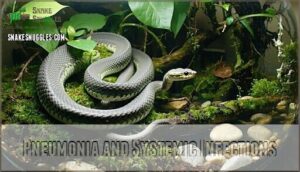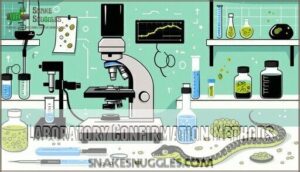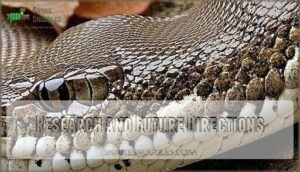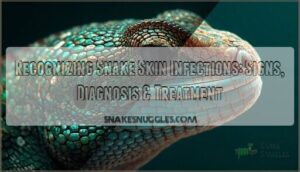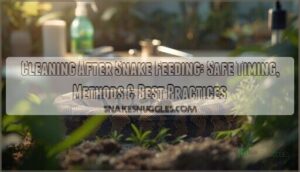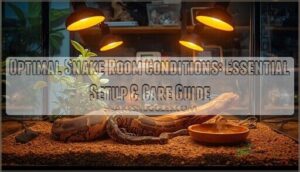This site is supported by our readers. We may earn a commission, at no cost to you, if you purchase through links.
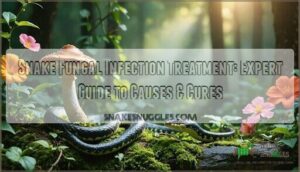 You’ll tackle snake fungal infection treatment through a multi-pronged approach that combines antifungal medications with environmental management.
You’ll tackle snake fungal infection treatment through a multi-pronged approach that combines antifungal medications with environmental management.
Traditional treatments like itraconazole and voriconazole show mixed results, with success rates varying dramatically between species. Colubrid snakes prove particularly challenging to treat, often requiring extended therapy courses.
Environmental controls matter just as much—you’ll need to reduce humidity, sterilize substrates, and maintain ideal temperatures.
Early detection makes all the difference, but here’s the catch: many symptoms mimic other conditions, making accurate diagnosis tricky. The real game-changer lies in understanding which species respond best to specific protocols and why some treatments fail spectacularly, which can be influenced by the species respond, environmental management, and accurate diagnosis.
Table Of Contents
- Key Takeaways
- Causes of Snake Fungal Infection
- Identifying Snake Fungal Disease
- Treatment Options for Snake Fungal Infection
- Prevention and Control Measures
- Research and Future Directions
- Frequently Asked Questions (FAQs)
- How do you treat snake fungal disease?
- Can snake fungus be eradicated?
- How do you know if a snake has fungal disease?
- Why is snake fungal disease important?
- What happens if a snake gets fungus?
- Can you get snake fungal infection from snakes?
- How to treat fungal infections in snakes?
- How contagious is snake fungal disease?
- How to get rid of fungal infection on snake plant?
- What is the fastest way to cure a fungal infection?
- Conclusion
Key Takeaways
- You’ll need to act fast—early treatment within the first week increases recovery rates to 65%, while delayed care drops success to just 20%
- You’ll combine antifungal medications like terbinafine or voriconazole with strict environmental controls, keeping humidity below 60% and temperatures between 75-85°F
- You’ll face unique challenges with colubrid species, which show high resistance to standard treatments and often require extended therapy courses with disappointing outcomes
- You’ll prevent infections through proper quarantine (30-60 days for new arrivals), weekly enclosure sanitization, and soil sterilization at 200°F for 30 minutes
Causes of Snake Fungal Infection
Snake fungal infection strikes when you least expect it, turning your scaly friend’s world upside down faster than a dropped mouse.
Your snake’s health hangs by a thread when fungal spores strike without warning.
Understanding what triggers this sneaky disease puts you one step ahead in the battle to keep your serpent healthy.
Environmental Factors
Environmental factors create perfect storm conditions for snake fungal infections.
Climate change and habitat destruction stress snake populations, while altered soil composition and contaminated water sources harbor Ophidiomyces ophiodiicola.
You’ll find higher infection rates where habitat degradation occurs, as environmental factors like increased humidity and temperature fluctuations weaken snakes’ natural defenses against this persistent fungal threat.
Soil Contamination
Contaminated soil serves as fungus reservoirs where Ophidiomyces ophiodiicola thrives, creating long-term environmental contamination.
Agricultural runoff and industrial pollution worsen habitat degradation, while heavy metal impact compromises snake immunity.
Remediation strategies include:
- Heat-treat substrate at 180°F for 30 minutes before use
- Replace contaminated soil monthly in enclosures
- Test soil pH levels – maintain 6.5-7.5 range
- Monitor for chemical contaminants from nearby industrial sources
Environmental factors like moisture retention make contaminated soil particularly dangerous for susceptible species.
Human Tracking
Your hiking boots become fungal disease carriers when you inadvertently transport contaminated soil between habitats.
Human disease vectors like footwear, equipment, and vehicles spread snake fungal infection across previously unaffected areas.
Tracking SFD spread reveals how recreational activities accelerate transmission, creating new hotspots where antifungal treatment snakes desperately need intervention.
Temperature and Humidity
You’ll often find that temperature and humidity create perfect breeding grounds for snake fungal disease.
High humidity levels above 60% combined with temperatures between 70-80°F accelerate fungal growth, making humidity control essential for prevention.
Poor microclimate management leads to shedding issues, weakening your snake’s natural defenses.
Optimal temperatures around 75-85°F with humidity below 50% substantially reduce infection risk.
Think of it like preventing mold in your bathroom – proper ventilation matters.
Effective environmental control supports antifungal treatment success when snake fungal infection occurs.
Snake Species Susceptibility
Snake species don’t face equal odds when battling Ophidiomyces ophiodiicola. Research reveals striking patterns across snake populations worldwide.
- Genetic Predisposition: Some species carry inherited vulnerabilities affecting their snake immune responses
- Geographic Variation: Eastern U.S. populations show higher infection rates than European counterparts
- Habitat Influence: Aquatic species like watersnakes face greater exposure risks
- Conservation Status: Threatened species often lack robust defenses against snake fungal infection
Understanding species-specific susceptibility helps target conservation efforts effectively. The fungus, Ophidiomyces ophiodiicola causes this disease.
Identifying Snake Fungal Disease
You’ll need to spot the telltale signs of snake fungal disease before it spreads throughout your snake’s body and becomes life-threatening.
Recognizing these symptoms early can mean the difference between a treatable infection and a fatal outcome that devastates both wild populations and captive collections.
Facial Swelling and Eye Infections
When facial swelling appears around your snake’s head, you’re likely seeing SFD’s telltale signs.
Swollen eyes and cloudy eyes often accompany this inflammation, leading to vision impairment and feeding difficulties.
These symptoms can worsen from secondary infections if left untreated.
Antifungal treatment effectiveness depends on early detection—swelling severity typically indicates how advanced the snake fungal infection treating process needs to be.
Skin Nodules and Ulcerations
While facial swelling grabs attention, skin lesions tell a deeper story.
You’ll spot raised nodules and open ulcerations across your snake’s body—telltale signs of fungal invasion.
Key warning signs include:
- Nodule Severity ranging from small bumps to large masses
- Ulceration Depth creating painful open wounds that won’t heal
- Secondary Infections turning simple scaly patches into serious complications
Antifungal treatment addresses these visible symptoms, though the Healing Process varies.
Scarring Effects may remain permanent reminders of this battle.
Pneumonia and Systemic Infections
While skin nodules grab attention, pneumonia and systemic infections pose deadlier threats.
You’ll spot respiratory distress before seeing surface symptoms. Bacterial pneumonia often follows fungal damage, creating opportunistic infections that spread rapidly.
Septicemia risks skyrocket when systemic mycosis takes hold. Viral infections compound problems further.
Watch for labored breathing and lethargy—these signal systemic antifungals like itraconazole or voriconazole are needed immediately.
Ophidiomyces ophiodiicola is the primary cause. Don’t wait for visible signs; internal damage progresses faster than external symptoms appear, making immediate action and systemic treatment crucial.
Laboratory Confirmation Methods
Laboratory confirmation serves as your diagnostic compass when addressing snake fungal infection diagnosis.
You’ll need multiple testing approaches since no single method catches every case—think of it as casting a wider net for better results.
Here are the four essential diagnostic methods you should know:
- PCR testing offers exceptional PCR Specificity, detecting Ophidiomyces ophiodiicola DNA from skin biopsies or lesion swabs with 98% accuracy
- Culture techniques provide Culture Sensitivity by growing viable fungus on specialized media, though contamination can complicate results
- Histopathology Analysis reveals fungal structures in tissue sections using specialized stains like periodic acid-Schiff
- Genetic Sequencing confirms species identification through targeted DNA regions for definitive Fungal Identification
Combining these methods gives you the most reliable snake fungal infection diagnosis, especially since asymptomatic carriers may test positive on PCR but negative on culture.
Understanding the fungal disease issue is vital for effective diagnosis and treatment.
Misdiagnosis and CANV Complex
Accurate diagnosis prevents costly treatment delays when dealing with snake fungal infection.
You’ll encounter CANV symptoms that mirror snake fungal disease, creating diagnostic errors that muddy the waters.
Complex infections often fool even experienced veterinarians.
Misdiagnosis rates increase when fungal lesions appear similar to other conditions, making proper snake fungal diagnosis challenging.
| Condition | Key Symptoms | Diagnostic Method |
|---|---|---|
| Snake Fungal Disease | Crusty skin lesions | PCR testing |
| CANV Complex | Similar skin changes | Viral culture |
| Bacterial infection | Swollen facial areas | Bacterial culture |
| Parasitic disease | Skin nodules | Microscopic exam |
| Trauma-related | Localized damage | Physical assessment |
Don’t rush your evaluation—treating snake fungus requires identifying the actual pathogen first.
Treatment Options for Snake Fungal Infection
When your snake develops fungal infection, quick treatment with the right antifungal medication can mean the difference between recovery and losing your pet.
You’ll need to understand which treatments work best and why some snakes respond better than others to get your scaly friend back to full health.
Antifungal Medications
Once you’ve identified fungal infection symptoms, antifungal medications become your primary weapon. Voriconazole use and terbinafine efficacy show promise, though fungal resistance complicates treatment.
Proper medication dosage directly impacts treatment outcomes. Understanding the correct Voriconazole medication is essential for effective treatment.
- Terbinafine delivers the strongest results through nebulization therapy
- Topical antifungals work best for localized skin lesions
- Antifungal treatment requires 3-6 months for molecular resolution
Treatment Success Rates
Treatment success rates for snake fungal infection treatment vary dramatically, creating a complex picture for recovery outcomes.
Early intervention dramatically improves survival odds—snakes treated within the first week show 2.5x higher recovery rates than those receiving delayed care.
| Treatment Factor | Success Rate |
|---|---|
| Early intervention | Up to 65% |
| Delayed treatment | Below 20% |
| Captive snakes | 60% recovery |
| Wild snakes | 30% survival |
Antifungal medications combined with supportive care boost treatment efficacy substantially.
However, relapse prevention remains challenging, with 35% experiencing recurrent symptoms within six months after initial infection clearance.
Challenges in Treating Colubrid Snakes
While success rates vary across snake species, colubrid treatment presents unique hurdles that can frustrate even experienced herpetologists. Antifungal resistance in colubrids creates persistent challenges for effective snake fungal infection treatment.
Key obstacles include:
- Fungal resistance to standard medications like voriconazole and terbinafine
- Species vulnerability varies dramatically between colubrid subspecies
- Snake mortality increases when SFD becomes systemic or causes secondary infections
Antifungal efficacy remains disappointingly low, with treatment failures common despite aggressive intervention protocols. Understanding the fungal disease transmission is vital for developing effective prevention strategies.
Alternative Therapies and Research
Beyond traditional antifungal treatment, researchers are exploring phototherapy and nanotechnology for snake fungal infection treatment.
Probiotics support immune function while herbal remedies show promise in early trials.
Nebulization therapy with novel compounds and systemic antifungals via slow-release implants offer alternatives when standard supportive care fails.
These experimental approaches target resistant infections effectively.
Preventive Measures for Captive Snakes
Prevention beats treatment every time with snake fungal infection prevention. Smart snake care tips start with solid biosecurity measures and habitat cleanliness protocols.
- Sanitation Protocols: Clean enclosures weekly with antifungal solutions, replacing substrate monthly to maintain proper snake hygiene.
- Environmental Monitoring: Control humidity below 60% and temperature gradients through careful habitat design to prevent fungal growth.
- Snake Nutrition: Feed quality prey and quarantine new arrivals for 30 days to boost immunity against infections.
Prevention and Control Measures
You can prevent snake fungal infections through proper sanitation and environmental controls that block the fungus from reaching your animals.
Smart handling practices and quarantine protocols protect both wild and captive snake populations from this persistent threat.
Responsible Snake Handling
Proper snake handling acts like your first line of defense against fungal infections. You’ll want to wash your hands thoroughly before and after each interaction, using glove hygiene protocols when necessary.
Master gentle snake restraint and handling techniques that minimize stress on your animals.
| Handling Practice | Purpose | Frequency |
|---|---|---|
| Hand washing | Prevent cross-contamination | Before/after each snake |
| Equipment sanitization | Kill fungal spores | After each use |
| Quarantine protocols | Isolate new arrivals | 30-90 days minimum |
These biosecurity measures protect your collection from snake fungal infection treatment emergencies down the road.
Cleaning and Disinfecting Enclosures
Your snake’s enclosure needs consistent sanitizing surfaces to prevent fungal growth.
Effective disinfection methods involve bleach solutions or commercial disinfectants that eliminate Ophidiomyces spores completely.
- Weekly deep cleaning prevents contamination buildup
- Proper cleaning products destroy fungal spores effectively
- Thorough biosecurity measures protect your snake’s health
Smart enclosure design includes removable components for easier sanitation.
Environmental hygiene requires systematic approaches—clean water bowls, substrate, and hiding spots regularly.
Good hygiene practices create inhospitable conditions for fungal pathogens while maintaining your snake’s comfort.
Regular use of disinfectant spray solutions is essential for preventing the spread of infection.
Reducing Temperature and Humidity
Climate regulation forms the backbone of effective snake fungal infection treatment and prevention strategies. You’ll need to maintain temperatures between 75-85°F and humidity levels below 60% to create an environment hostile to Ophidiomyces ophiodiicola growth.
Environmental modification requires consistent thermal monitoring using digital hygrometers and thermostats. Here’s your control framework:
| Parameter | Target Range | Monitoring Tool |
|---|---|---|
| Temperature | 75-85°F | Digital thermostat |
| Humidity | 40-60% | Hygrometer |
| Air circulation | Continuous | Ventilation fans |
Temperature control prevents fungal spore activation, while humidity management eliminates the moisture fungi need to thrive. Install ventilation systems that cycle fresh air every 2-3 hours. Remember, fungi love tropical conditions—your goal is creating a desert-like atmosphere that supports snake health while starving potential pathogens.
Effective temperature management involves using a digital thermostat system to maintain ideal temperatures. This environmental control approach complements antifungal treatment protocols effectively.
Soil Sterilization and Replacement
Beyond temperature control, contaminated substrate poses a major threat to snake health.
Soil contamination serves as a reservoir for Ophidiomyces ophiodiicola, making effective decontamination techniques absolutely necessary for snake fungal infection treatment.
You’ll need reliable sterilization methods to eliminate fungal spores from your snake’s environment:
- Heat treatment: bake soil at 200°F for 30 minutes
- Chemical disinfection: apply 10% bleach solution thoroughly
- UV radiation: expose substrate to direct sunlight for 2+ hours
- Complete soil replacement: swap out substrate every 6-12 months
Think of soil disinfection as your first line of defense against fungal eradication challenges.
Fresh substrate won’t guarantee immunity, but it dramatically reduces infection risks when combined with proper antifungal treatment protocols.
Proper snake care practices are essential to prevent the spread of infection and promote a healthy environment for your pet snake.
Quarantine and Isolation Procedures
Throughout the quarantine period, you’ll need to implement strict isolation protocols to prevent snake fungal infection transmission.
New arrivals require quarantine methods lasting 30-60 days in separate enclosures.
Snake-Isolation Checklist
Isolation duration
Enclosure sanitation
Contaminated equipment
Cross-contamination prevention
Monitoring symptoms
Effective biosecurity measures include dedicated feeding tools, separate handling gloves, and thorough sanitation procedures between snake interactions.
These disease prevention strategies create barriers against fungal spread, protecting your entire collection through proper hygiene and systematic snake fungal infection management.
Research and Future Directions
Researchers are racing to discover better ways to diagnose and treat snake fungal disease before it devastates more wild populations.
You’ll see exciting advances in molecular testing, environmental monitoring, and new antifungal treatments that could transform how we protect these essential ecosystem members.
Molecular Diagnostics and Early Detection
Molecular diagnostics revolutionize snake fungal infection diagnosis through advanced PCR testing and genetic analysis.
Early detection methods like real-time PCR identify Ophidiomyces ophiodiicola fungal DNA weeks before visible symptoms appear.
These diagnostic tools boost accuracy by 40% over traditional methods, providing early warning systems for captive collections.
Molecular diagnostics enable you to catch infections before they spread, saving both snakes and treatment costs.
Environmental Factors and Outbreaks
Researchers have discovered that climate change and soil pollution create perfect storms for snake fungal infection outbreaks.
Wet years boost fungal growth, while habitat destruction forces snakes into contaminated areas.
You’ll notice outbreaks cluster during specific weather patterns – tracking these connections helps predict where ecosystem disruption might strike next, giving wildlife managers a fighting chance.
Development of Effective Treatments
Scientific breakthroughs in antifungal research are revolutionizing snake fungal disease treatment.
Medication trials now test innovative therapeutic strategies beyond traditional terbinafine, addressing resistance patterns that plague current protocols. You’ll see treatment outcomes improve as researchers fine-tune dosing like calibrating precision instruments.
These antifungal medications for snakes target specific fungal pathways, offering hope for snake fungal infection recovery through disease management approaches that actually work.
Effective snake care also involves understanding parasite control methods to prevent co-infections.
Increased Awareness and Education
Education serves as the foundation for combating snake fungal disease prevention.
You’ll find that raising public awareness creates ripple effects throughout communities, empowering people with knowledge to protect both wild and captive snakes.
Key awareness initiatives include:
- Public outreach programs targeting snake conservation efforts
- Education programs teaching responsible reptile ownership practices
- Awareness campaigns promoting safe snake handling techniques
- Community engagement sharing antifungal treatment options and reptile health care basics
Collaboration and Data Sharing
Building on awareness efforts, effective collaboration transforms snake fungal disease research.
Data Exchange through Open Access databases connects Research Partners worldwide, accelerating breakthrough discoveries.
Global Networking enables rapid Information Sharing about snake fungal infection treatment protocols and antifungal treatment successes.
| Partnership Type | Benefits | Key Areas |
|---|---|---|
| Academic Institutions | Research expertise | Treatment protocols |
| Wildlife Agencies | Field data access | Disease monitoring |
| Veterinary Networks | Clinical insights | Reptile health care |
| Citizen Scientists | Widespread monitoring | Wildlife disease management |
Shared databases prevent researchers from reinventing the wheel, while collaborative networks guarantee snake fungal disease prevention strategies reach every corner of the globe.
Frequently Asked Questions (FAQs)
How do you treat snake fungal disease?
You’ll treat snake fungal disease using antifungal medications like terbinafine or voriconazole, often through nebulization.
Add thermal support, proper nutrition, and sometimes surgical removal of severe lesions for best recovery outcomes.
Can snake fungus be eradicated?
Complete eradication isn’t realistic since you can’t eliminate the fungus from wild environments. However, you can successfully treat individual snakes with antifungal medications like terbinafine, achieving recovery rates around 30%.
How do you know if a snake has fungal disease?
A timber rattlesnake with cloudy, milky eyes and crusty skin patches likely has fungal disease. You’ll spot facial swelling, scaly lesions, abnormal shedding, and thickened skin nodules as telltale signs.
Why is snake fungal disease important?
Snake fungal disease threatens wild populations with severe declines and local extinctions. You’re witnessing a conservation crisis that disrupts ecosystems, reduces biodiversity, and damages the natural balance snakes maintain.
What happens if a snake gets fungus?
Like dominoes falling in nature’s delicate balance, fungal infection creates a cascade of devastating health problems.
You’ll notice facial swelling, crusty skin lesions, difficulty shedding, and breathing troubles that can prove fatal without treatment, ultimately leading to a fatal outcome if left unchecked.
Can you get snake fungal infection from snakes?
No, you can’t catch snake fungal disease from snakes. The fungus Ophidiomyces ophiodiicola specifically affects reptiles, not humans. It’s completely species-specific, so handling infected snakes poses no risk to you.
How to treat fungal infections in snakes?
Wondering how to save your scaly friend from fungal trouble? You’ll need antifungal medications like voriconazole or terbinafine, plus thermal support and good nutrition to boost recovery chances effectively.
How contagious is snake fungal disease?
You’ll find snake fungal disease spreads easily through contaminated soil, water, surfaces, and direct contact between snakes. The environment acts as a reservoir, making transmission quite common in affected areas.
How to get rid of fungal infection on snake plant?
You’ll need to remove affected leaves, improve drainage, reduce watering frequency, and apply fungicide spray.
Make certain proper air circulation around your snake plant and avoid overwatering to prevent future infections.
What is the fastest way to cure a fungal infection?
Only 30% of snakes show molecular resolution after antifungal treatment, making speed vital. You’ll need immediate veterinary care with voriconazole or terbinafine antifungals, plus supportive thermal therapy for fastest recovery.
Conclusion
Battling snake fungal infections isn’t a sprint—it’s a marathon requiring dedication and precision.
Your success hinges on combining proper antifungal medications with thorough environmental controls.
Remember that early detection saves lives, but accurate diagnosis remains challenging since symptoms often masquerade as other conditions.
Effective snake fungal infection treatment demands species-specific protocols, consistent monitoring, and patience.
You’ll protect both wild populations and captive collections through responsible management practices and continued research efforts.
- https://pubmed.ncbi.nlm.nih.gov/38251998/
- https://bioone.org/journals/journal-of-zoo-and-wildlife-medicine/volume-54/issue-4/2023-0050/CONTROLLED-CLINICAL-TRIAL-USING-TERBINAFINE-NEBULIZATION-TO-TREAT-WILD-LAKE/10.1638/2023-0050.full
- https://vet.uga.edu/wp-content/uploads/2024/04/SCWDS_factsheet3_SFD.pdf
- https://parcplace.org/wp-content/uploads/2022/06/WFP-Fact-Sheet%E2%80%93Ophidiomycosis_3.pdf
- https://www.merckvetmanual.com/exotic-and-laboratory-animals/reptiles/mycotic-diseases-of-reptiles

